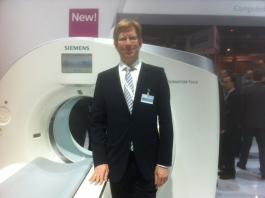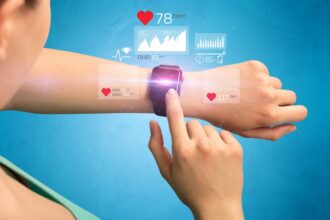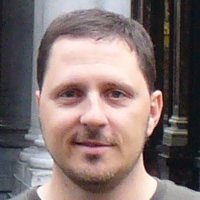 Exploring the Siemens “booth” at the annual meeting of the Radiological Society of North America is a bit like coming aboard the Starship Enterprise — a vast vessel with a crew to match.
Exploring the Siemens “booth” at the annual meeting of the Radiological Society of North America is a bit like coming aboard the Starship Enterprise — a vast vessel with a crew to match.
 Exploring the Siemens “booth” at the annual meeting of the Radiological Society of North America is a bit like coming aboard the Starship Enterprise — a vast vessel with a crew to match. (I know I’m mixing my space metaphors, thanks!) There I found Peter Seitz, ready to show me the spanking new SOMATOM Force, the next generation in Dual Source computed tomography (CT), which enables considerably faster imaging, more precise diagnoses and the possibility to achieve superior dose reductions for even more groups of patients.
Exploring the Siemens “booth” at the annual meeting of the Radiological Society of North America is a bit like coming aboard the Starship Enterprise — a vast vessel with a crew to match. (I know I’m mixing my space metaphors, thanks!) There I found Peter Seitz, ready to show me the spanking new SOMATOM Force, the next generation in Dual Source computed tomography (CT), which enables considerably faster imaging, more precise diagnoses and the possibility to achieve superior dose reductions for even more groups of patients.
The new system, which is pending 510(k) clearance from the FDA, extends advanced CT imaging capabilities and dose-reduction features to some of the most challenging patients, including the very young, suffering from renal insufficiency, seriously ill or obese.
Seitz, tall and genial, enthused about the new product. “With the very powerful generators we are able to use lower power and lower radiation dose for all patients,” he said. “It can be almost a ten-fold reduction for cardiac CT. The second effect is to reduce the amount of iodine contrast needed, which is good news for elderly patients or those with renal insufficiency.
“Above all, we are really fast,” continued Seitz. “We can do an entire chest and abdomen study in just one second. When you scan a lung, which is 30 centimeters, you take 0.3 seconds. When you scan a heart, 0.15 seconds. So we are really, really fast. This is really important because the first thing you hear from a tech during a CT scan is a breath-hold command. We are so fast you don’t need a breath-hold anymore.” In fact, because of its acquisition speed, even patients with hight heart rates can be imaged without disruptive motion artifacts. SOMATOM Force has delivered diagnostic-quality images at a low dose for a patient with a 90 beats-per-minute heart rate, with no use of beta blockers to slow the heart rate.
“This will of course benefit all patients where motion is an issue, such as pediatric patients,” said Seitz. “For example, for newborns who might have congenital heart disease, we are talking 0.1 second scanning. The scan speed is three to four times anything out there and almost twice our previous generation of this machine.”
The new generation also is capable of dynamic imaging, which is very valuable information for vascular surgeons.
Okay, beam me up, Peter!
Click here for more information about Siemens at RSNA:
Disclaimer: Mr. Goldstein is paid by Siemens Healthcare for his reporting on RSNA.

.jpg)






